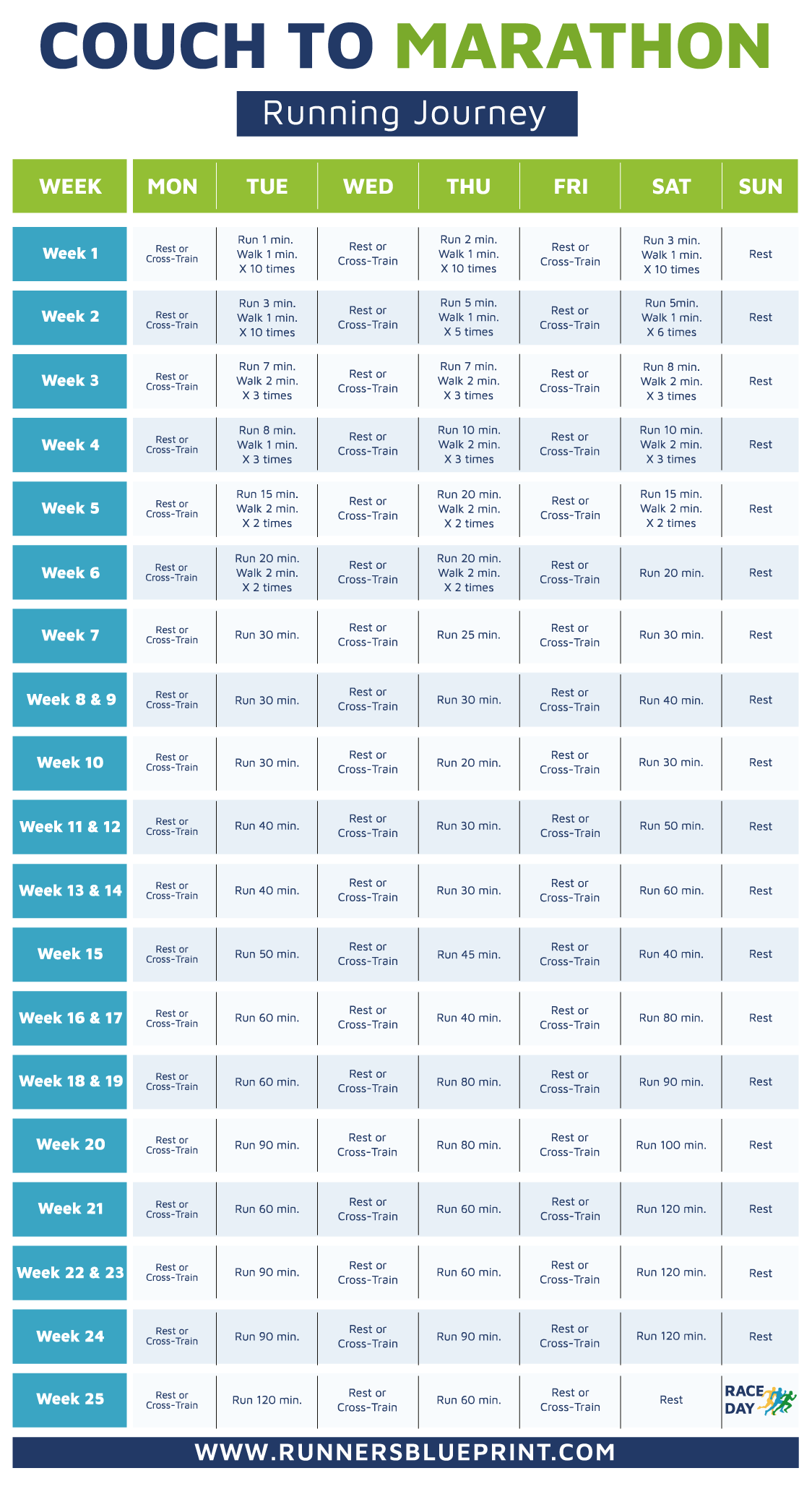Feeling ready to conquer your first marathon? Then you’ve come to the right place as I got the perfect couch to marathon plan to help you achieve your goal.
Going from couch to marathon may seem like an impossible feat, but just like climbing a mountain, every step counts towards reaching the summit. And when you finally cross the finish line, the sense of accomplishment and pride will be truly breathtaking.
But let’s not rush into things. This six-month training plan takes a gradual and progressive approach to ensure you reach your goals safely and efficiently. It’s like a slow-cooked stew where every ingredient adds its own unique flavor to create a delicious and fulfilling outcome.
In this comprehensive training plan, we’ll cover everything you need to know for a successful marathon. From the half marathon training plan to the necessary gear, we’ll guide you through the process step-by-step.
But it’s not all about the training. I’ll also discuss the importance of tapering, racing tips, and so much more.
So grab a drink, sit back, and let’s dive into this exciting journey together.
How Far is the Marathon?
Let’s start at the very beginning and answer the age-old question: how far is the marathon, really?
Here’s the rundown:
A marathon is 26.2 miles, or for our metric system friends, a whopping 42.5 kilometers.
That’s like running 105.5 laps around a standard outdoor 400-meter track. At a 12-minute mile pace, it’ll take you roughly 5 hours and 15 minutes to cross that finish line.
How Long to Train for a Marathon?
The answer? It depends. Are you starting from scratch, or do you have a good running base already? Are you injury-free and ready to tackle this challenge?
As a general rule, aim to spend at least six months training for your first marathon—assuming you’re already in shape and not suffering from any injury or chronic condition.
As a general rule, plan to spend at least six months training for your first marathon. You’ll gradually increase your mileage and build up your endurance, all while avoiding injury and burnout.
And if you’ve been running regularly for the past year, you might be able to tackle a marathon in just eight to twelve weeks. But remember, there’s no rush. Most standard marathon training plans are 16 to 20 weeks long, giving you plenty of time to prepare and crush those miles.
Keep in mind that you might need some form of knee support for running like this one https://threo.co.uk/
My plan spans roughly six months –or more than 25 weeks—of consistent training.
You can go from the sofa to the finish line of a marathon in roughly six months—as long as you’re healthy. You’ll usually run three to four times a week during this time, increasing your weekly volume as you get closer to race day.
How Long Does it Take to Train for a Marathon – The Pre-Requisites
Before you jump into the couch to a marathon training plan, there are a few conditions you should fulfill first.
It’s true that the more out of shape you are, the more uphill the battle will be to get race-ready.
But don’t fret yet.
With the right training plan, a bit of grit, and some perseverance, you can go from couch potato to marathon finisher in as little as six months.
However, before you start your marathon training, you should fulfill some prerequisites like having some existing fitness from endurance training, such as cycling, or having experience logging miles, even for a short time.
Marathon Training Gear
Whether training for your first marathon or trying to clock a 3-hour race, the right gear can make all the difference.
And speaking of preparation, let’s talk about gear. While running doesn’t require a ton of equipment, there are a few things you’ll want to invest in for your marathon journey. Marathons can be challenging events—and when you don’t have the right kit for the job, you’ll be making it harder for yourself to run your best race.
But don’t make the rookie mistake of trying out new gear on race day. It’s like going into battle with untested weapons—you’re setting yourself up for failure.
Stick with what you know works, and save the flashy new gear for training. Even the most expensive shoes on the market won’t do you any good if they don’t fit right or you haven’t broken them in. So, choose your gear wisely and stick with what’s tried and true.
T-Shirt
Choosing the right t-shirt for your marathon is like picking your running soulmate. It’s all about compatibility and finding the perfect match for your needs. Don’t be seduced by cotton’s soft touch, though. It’s like a clingy ex that will only bring you pain in the long run. Instead, opt for Polypropylene, a lightweight fabric that wicks moisture away from your skin like a thirsty bartender. Say goodbye to chafing and discomfort and hello to dry and comfortable running.
Leg Wear
Your legs are like the wheels of a car, and you wouldn’t want to compromise performance with baggy or heavy clothes. Go for something light, airy, and comfy, like a breeze on a hot summer day. Short shorts, long shorts, whatever floats your boat, as long as they don’t get in the way of your stride. You don’t want to look like a sailboat or a hobbit, after all.
Sports Bra
Sports Bra Ladies, your sports bra is the foundation of your running outfit. It’s like the concrete that keeps your house standing. Don’t underestimate its importance, or you’ll regret it later. Invest in a high-quality bra that offers excellent support and adjustable straps to ensure a snug fit. You don’t want to be bouncing around like a basketball on the court.
Have trouble finding the right size? Choose a bra with adjustable bands and straps.
Socks
Your feet are the unsung heroes of your marathon journey, and they deserve some TLC. Think of your running socks as a cushy cloud that envelops your feet in comfort. Look for seamless, snug-fitting socks that provide plenty of padding and support to minimize the risk of blisters. It’s like a warm hug for your tired feet.
Prefer shorter socks? Go for a pair that at least covers a portion of your ankle to prevent the back of your shoes from rubbing on your skin.
Running Hat
Don’t let the sun or sweat blind you during the race. A running hat is like a trusty wingman that shields your eyes and face from the elements.
It’s like a superhero cape that helps you stay focused on the road ahead.
Opt for a hat that fits snugly and doesn’t obstruct your vision, so you can avoid any potholes or obstacles that come your way. Trust me, a twisted ankle is not a fun way to end a race.
Running Shoes
Of course, you’ll need shoes to run the marathon.
You might be able to get away with other gear, but race day is not the time to take your new running shoes for a ride. This is the case whether it’s a marathon, or a shorter distance such as the 10K.
Instead, run in well-broken running. At a minimum, plan to run about 100 to 120 miles in your shoes before race day to make sure they’re properly broken in.
Furthermore, keep in mind that your feet might swell up to full size after extended time on your feet—which is the norm during marathon running.
The Walk /Run Method
During the first few weeks, you’ll be doing a set of walk/run sessions to get used to running non-stop for a relatively long period.
For example, the first session consists of a one-minute run and a one-minute walk, repeated ten times.
It should take you roughly 30 minutes to finish the whole session—including the warm-up and cool-down.
As the weeks go by, you’ll spend more time running and less and less walking until you can jog straight for 30 to 40 minutes without much trouble.
Progress The Slow Way
Slow and steady wins the race, so don’t feel like you have to push yourself too hard too soon. Remember the 10 percent rule: increase your total weekly mileage by no more than 10 percent from one week to the next.
This seems too much to digest? Don’t worry. The couch to marathon plan below explains in detail the exact process to follow to build up mileage safely and pain-free.
Additional resource – Maintaining muscle during marathon training
Easy Training Runs
Easy training runs vary in length from three miles to 6 miles and help you add weekly volume to your running plan.
As for speed, shoot for a sustainable and comfortable pace, especially during your first few runs—when you have just graduated from the walk/run method.
All in all, allow your body to lock in a pace you can keep up for 30 minutes and follow that.
Additional resource – Marathon pace chart
Build Your Marathon Long Runs
Whether you’re looking to finish your first marathon or want to pull off a sub-3:00 event, long runs are key.
Long runs are the bread and butter of endurance training—especially marathon training. These sessions consist of long, steady-state runs usually performed on the weekend.
How come?
Long runs help your body adapt to extended periods of running. In addition, they simulate real marathon running conditions, which helps to physically and mentally prepare for tackling the 26.2-mile beast.
Once you’re a few weeks in, start building up your weekly long runs. These should be performed once a week, extending the session by a mile or two.
Your first step?
Start with a distance that you can easily run—say six miles—and then progressively build it up.
On the third or fourth week, scale it back by a few miles to avoid injury or burnout.
For example, you might run six miles on Saturday, seven miles the next, nine miles next, and then seven again before moving to 10 or 11 in the fifth week.
This is the mindset you should adopt when increasing your overall mileage—whether it’s for the long run or your total weekly load.
Long Run Pace
As for pace, stick to an easy and conversational pace. You should be able to keep a conversation with a running buddy. But if you’re huffing and puffing, you’re going too fast.
Cross-Training
Marathon training isn’t just about the miles—your cross-training workouts also matter.
On the non-running days, perform low-intensity, low-impact training to help improve your conditioning and overall strength without putting extra stress on your legs.
This is what’s known as cross-training.
Cross-training consists of low-impact training that keeps your heart rate at a medium level for a lengthy period.
All in all, I recommend strength training, cycling, swimming, yoga, and Pilates.
All of these help you build endurance and strength without adding extra stress to your running legs.
Additional Resource – Your Guide To Runners Nipples
Fuel your Efforts
Proper marathon training isn’t just about the miles. You also need to get your diet up to speed.
The fact is, your nutrition is as much as important as your training plan.
To fuel your training, bulk up with high-carb, low-fiber foods (pasta, bread, grains, etc.). You should also eat plenty of good fats (avocados, oils, nuts, etc.) and lean protein (fish, meat, and chicken). Have more water and electrolytes; and more calories for endurance training.
Additional resource – Keto marathon training
Time Your Nutrition
Don’t ignore your post-run diet. I’d recommend a carb-protein drink, such as a recovery sport shake, within the recovery window.
Other great examples of good pre-run options include a banana, a bagel with peanut butter or an energy bar.
You should also experiment with various types of fuel on your training days to see which ones work the best. Then choose to follow the same fueling strategy during the race itself.
What’s more?
Stay well-hydrated by drinking plenty of water throughout the day—not just around your runs. Carry your water for long runs to keep you well hydrated.
Sidestep Injury
Are you a runner trying to avoid the dreaded sidestep injury? It’s like dodging potholes on a rainy day. High-mileage running increases your chances of injury, but don’t worry, I’ve got your back.
If you feel pain, don’t just sweep it under the rug like it’s no big deal. Even a small twinge can snowball into a serious injury that’ll knock you off your marathon training plan.
Grab an ice pack, take some anti-inflammatory meds, and, most importantly, rest up to let your body heal. Trust me; pushing through the pain isn’t going to get you anywhere except for the sidelines.
Remember, there’s no room for “It’s okay, I can run through it.” Proceed with caution, my friend.
What’s more?
Follow the 10 percent rule at all times, work on developing proper running form, and aim to build a strong to help you dodge injury and stay on track.
Taper Right For Marathon Training
The weeks leading up to your marathon are the most crucial, which is why all great marathon training plans have a taper period.
Imagine you’re driving your car down a hill on rainy day. You don’t want to brake too hard and lose control; instead, you gradually ease off the gas and keep moving under control. The same thing applies to your body.
This latter phase of training helps reduce accumulated fatigue and recharge your body after all the training. This, in turn, ensures that you’re well-rested so you can reach your full potential on race day.
Don’t know how to taper? Don’t worry. This is how:
- Two weeks out: Resist the urge to run harder or longer, as doing so will only compromise your efforts. Excess energy? Cross-train, but stay low impact.
- One week before: Cut your mileage to half of your normal training volume and keep your usual pace for the most part. Focus on recovery during the last week.
How To Train For A Marathon – The Couch to Marathon Plan
Now that you’re injury-free and tapered, it’s time to jump into the Couch to Marathon Plan. It’s like going from a caterpillar to a butterfly, except the end result is a marathoner. With consistent training, it’ll take you six months or less to reach your goal. Start with a 5K distance and work your way up to a full marathon.
The traits of a proper marathon training program consist of the following:
- Running three to four times per week
- Two to three cross-training days per week
- One to two rest days per week
- One long run a week
What’s more?
I’d recommend that you consider working with a running coach to create a customized plan that suits your fitness level and goals. They can help you tailor your training plan to fit your needs, whether you are a beginner or an experienced runner
And that’s it! You’re now a marathon-training expert. So, lace up those shoes, grab your water bottle, and get ready to crush your marathon goals. And remember, leave your comments and questions below and happy marathon training!
If you feel that making the jump to the couch to marathon training plan is too much, then feel free to check out my other beginner’s plans:
- The couch to 5K plan
- The sub 4 hour marathon pace training plan
- The couch to 5K treadmill plan
- The couch to 10K plan
- The couch to a half marathon plan.
- Before you sign up for a marathon
Note – Click HERE to download the PDF version of my couch to a marathon plan.
Note – Click HERE to download the PDF version of my Couch to a Marathon plan.
Couch to Marathon Plan – The Conclusion
Congratulations, you’re on your way to conquering a marathon with our simple and effective couch-to-marathon plan!
Armed with the knowledge of how to train and how long it takes to prepare, you can now confidently tackle this challenge without fear of failure.
Remember, the journey to the marathon is just as important as crossing the finish line. Embrace the process, stay consistent, and believe in yourself every step of the way.
If you have any questions or want to share your progress, please leave a comment below.
Thank you for visiting my humble blog today and we wish you the best of luck on your marathon training journey.
Let’s crush those goals together!




